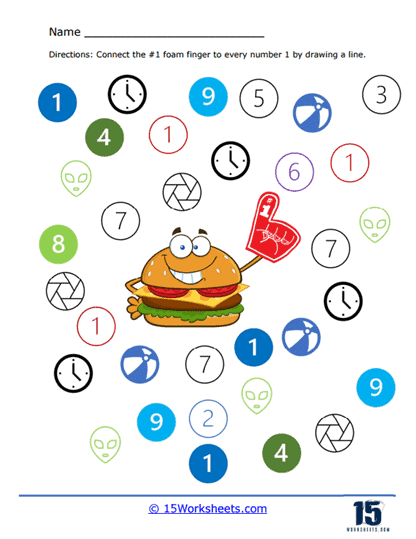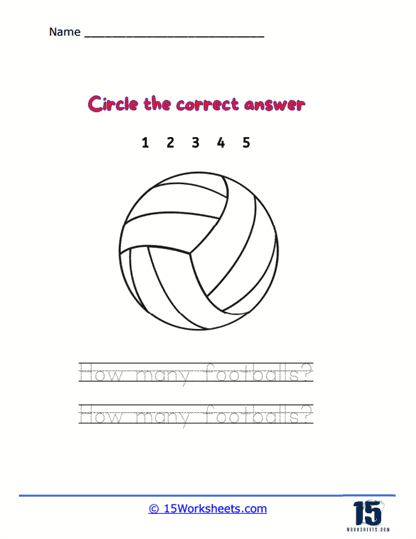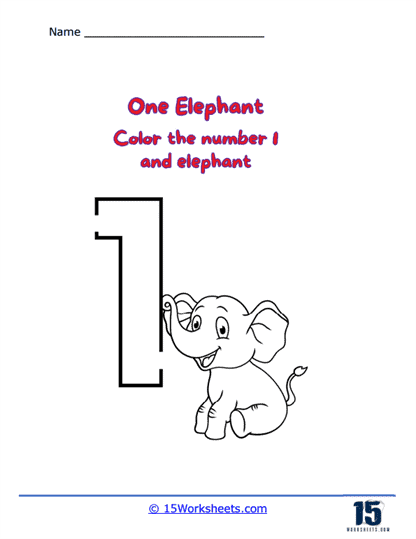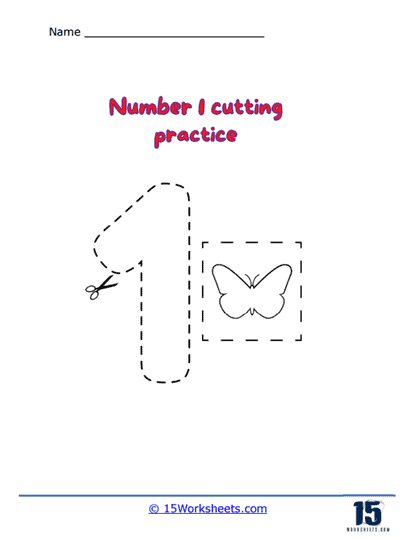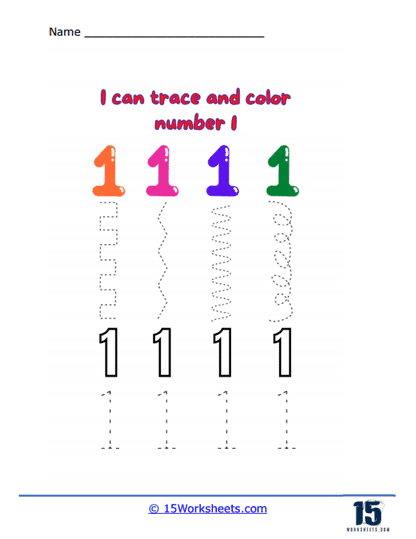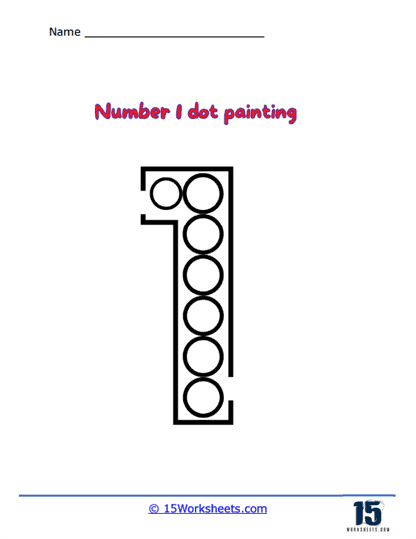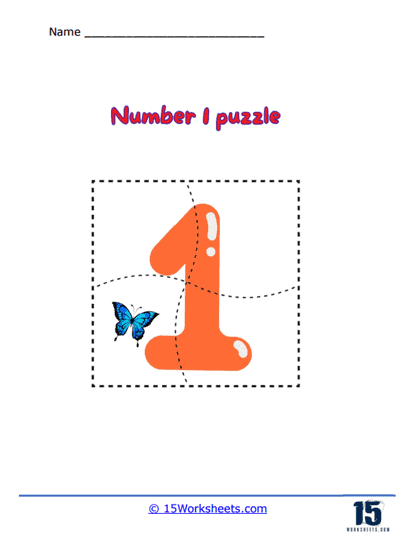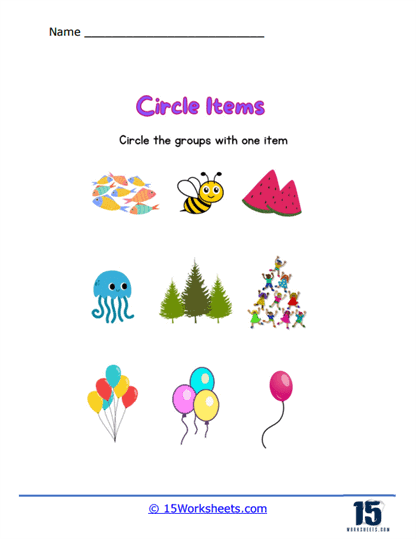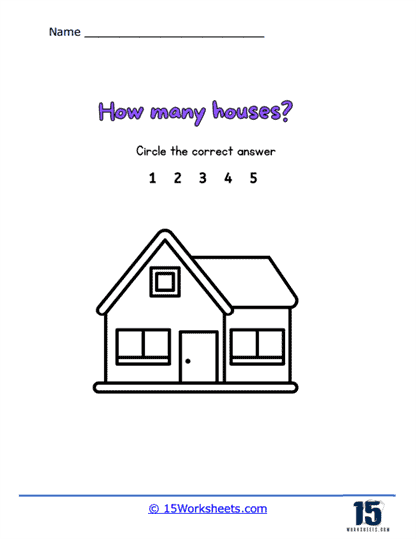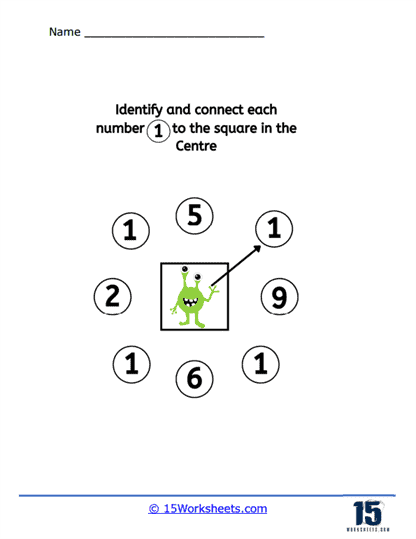Number 1 Worksheets
About These 15 Worksheets
Number 1 worksheets are instrumental learning tools that aim to help primary level students understand the number 1. These worksheets are filled with engaging and interactive exercises, which not only focus on recognizing and writing the number 1 but also understanding the basic mathematical concepts associated with it. The activities encompass a variety of exercises such as tracing, coloring, counting, and simple arithmetic problems that all contribute to the improvement of a child’s numeracy skills.
The worksheet series begins with a tracing exercise where the child is guided to follow dotted lines to write the number 1, both in its numerical form “1” and in its word form “one”. This activity serves a dual purpose. Firstly, it enhances the child’s handwriting skills as they learn to control their hand movements to write the number 1 correctly. Secondly, it helps children to memorize the form and appearance of the number 1 and the word “one”, which is a crucial step in number recognition.
The tracing exercise is often followed by a coloring activity. Here, the child might be asked to color in one object out of a group. This is a visual and interactive way for children to understand that the number 1 corresponds to a single object, reinforcing the fundamental concept of counting and quantity associated with the number 1.
Counting activities on these worksheets further emphasize this concept. The child may be asked to identify groups that contain one item amongst multiple groups with varying quantities. Such exercises not only reinforce the recognition of the number 1 but also enhance the child’s ability to distinguish it from other numbers.
Matching exercises are also included in these worksheets. Here, the child might be tasked to match the number 1 with an image of a single item. This activity helps to strengthen the association between the numerical symbol “1” and the quantity it represents. Simple arithmetic problems that involve the number 1, such as 1 + 0 or 2 – 1, are also often featured. These activities introduce the child to basic mathematical operations using the number 1, preparing them for more advanced arithmetic.
Thise set of worksheets serve as a fundamental building block in a child’s numerical literacy. Understanding the number 1 is a gateway to learning other numbers and grasping basic mathematical concepts. They also foster an understanding of the abstract concept of numbers. They help children realize that numbers represent specific quantities, which is a key concept in mathematics.
These worksheets cater to different learning styles, enhancing their effectiveness. Visual learners benefit from seeing the number and its associated quantity, auditory learners from hearing the number and instructions, and kinesthetic learners from tracing and writing the number. The colorful images and variety of activities keep the learning process engaging, which can motivate children to learn. When children find learning enjoyable, they are more likely to engage with the content and remember it, contributing to effective learning.
Introduction to simple arithmetic through these worksheets also exposes children to basic mathematical operations. This not only prepares them for more complex mathematical concepts but also cultivates their problem-solving skills, an essential cognitive skill.
Why Is The Number 1 So Special?
The number 1 holds a unique and special place in the world of numbers due to various mathematical and conceptual reasons. Here are a few points that highlight its uniqueness:
Fundamental Unit – The number 1 serves as the basic building block of the counting system. It’s the starting point from which all other numbers are formed. This fundamental nature makes it a key element in the development of numeracy skills and mathematical understanding.
Identity Element – In the realm of arithmetic operations, the number 1 has a special property known as an identity element. In multiplication, any number multiplied by 1 gives the original number. For example, 5 x 1 = 5. Similarly, in division, any number divided by 1 also yields the original number, for example, 7 ÷ 1 = 7. No other number has this property.
Indivisible Number – Number 1 is indivisible. It’s the only number that cannot be divided further into smaller whole numbers. In the language of mathematics, 1 is neither a composite number (a number that can be divided evenly by numbers other than 1 or itself) nor a prime number (a number that can be divided evenly only by 1 and itself).
Universal Truth – In any numbering system, irrespective of the base, the number 1 always represents a single unit of something. This consistency across systems highlights its universality.
Uniqueness in Powers – Any number raised to the power of 0 becomes 1, and any number raised to the power of 1 remains the same. Also, 1 raised to any power is always 1. This property is unique to the number 1.
Mathematical Constants – In many mathematical constants and formulas, the number 1 plays a crucial role. For instance, in the formula for calculating the area of a circle (πr²), if the radius (r) is 1, then the area of the circle is π, which is a fundamental constant in mathematics.
Symbolic Meaning – Beyond mathematics, the number 1 often symbolizes unity and singularity in various philosophical, spiritual, and cultural contexts. It can represent the concept of oneness or unity in diversity.
In Digital Systems – In digital systems and binary code, the number 1 (along with 0) forms the basis of all operations and functions. All information processed by a computer is ultimately broken down into sequences of 1s and 0s.
Basis of Percentage System – In the percentage system, 1 represents 1% of the total, and 100 times 1 forms the whole or 100%. It forms the base unit in this system.

